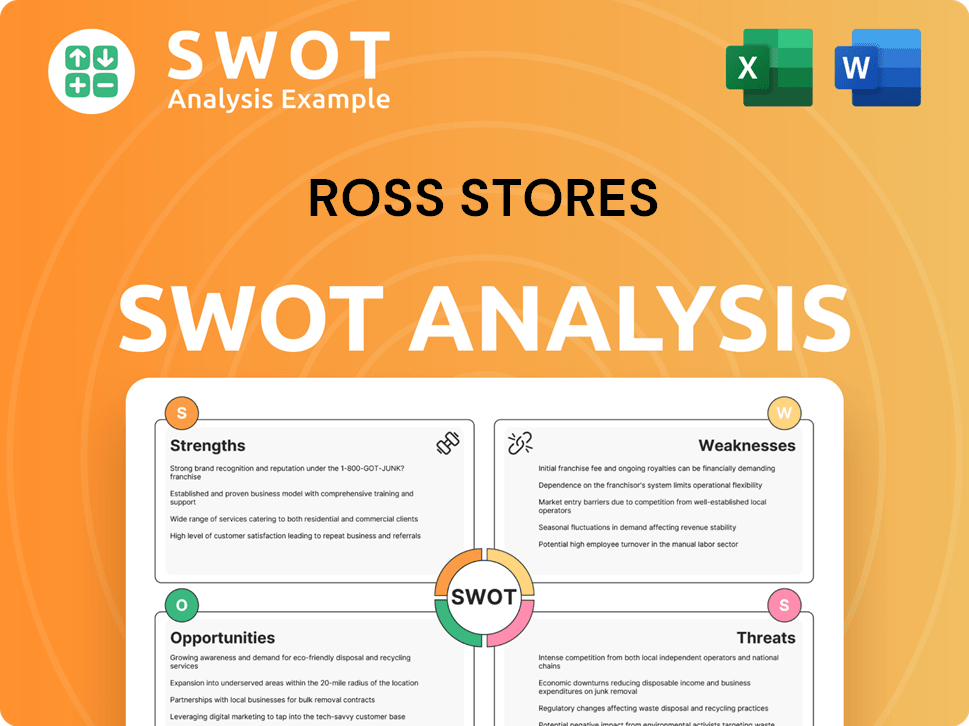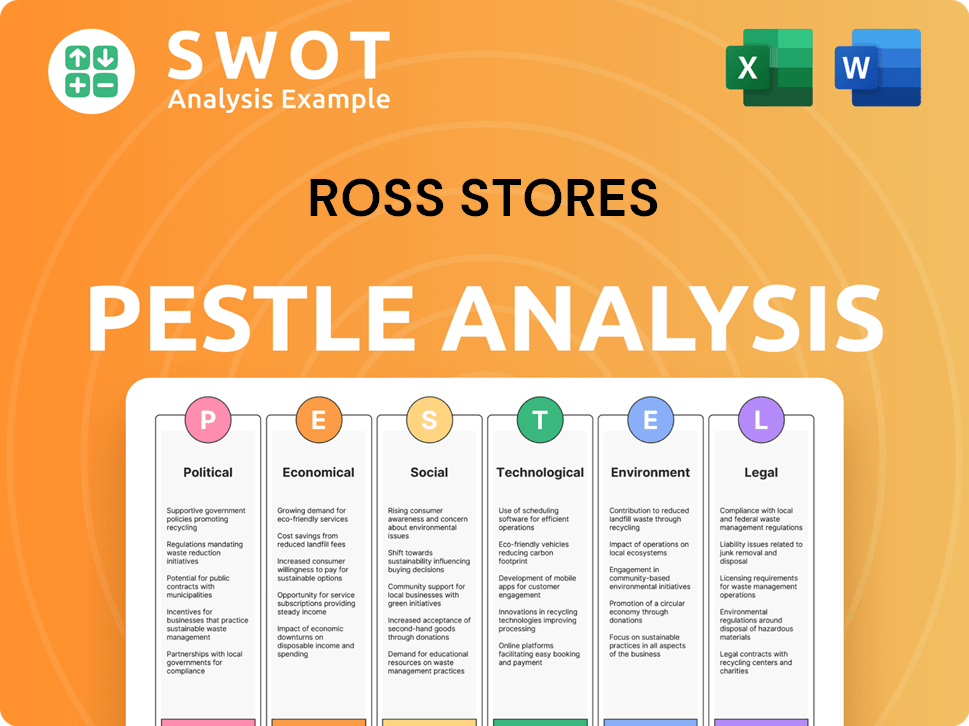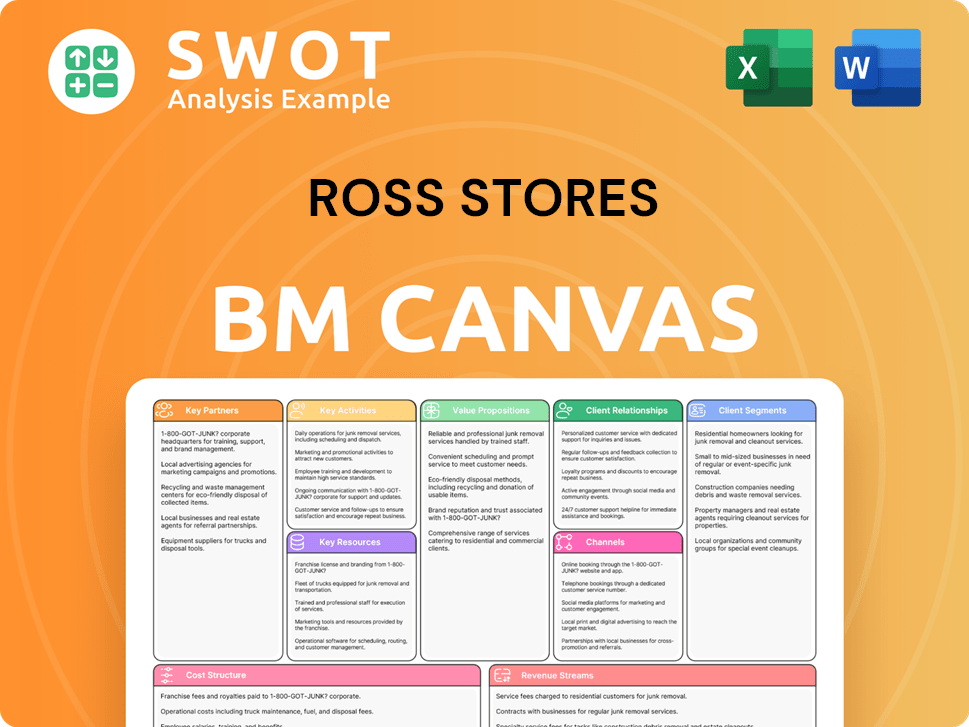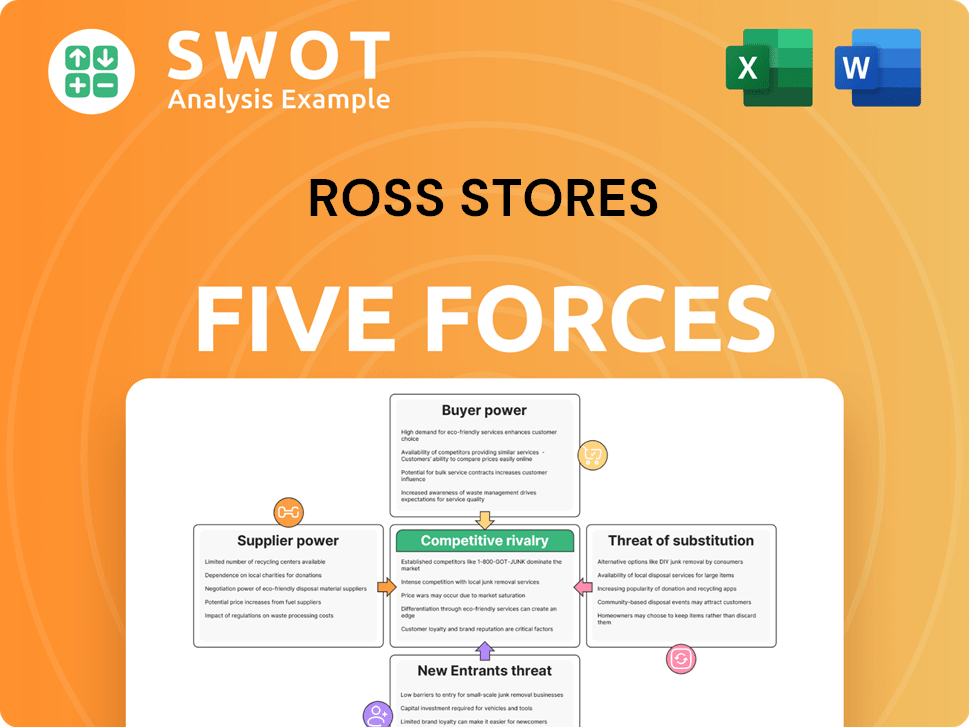Ross Stores Bundle
How Does Ross Stores Dominate the Discount Retail Market?
Ross Stores, a powerhouse in off-price retail, has built a successful business model by offering incredible value. Founded in 1982, the company has consistently provided brand-name merchandise at significantly reduced prices, attracting a broad customer base. This approach, centered on deep discounts and a unique shopping experience, has been key to its sustained growth.

This article will explore the Ross Stores SWOT Analysis, delving into the specifics of their sales and marketing strategies. We'll examine how Ross Stores attracts customers, their pricing strategy analysis, and advertising methods, alongside its competitive advantages in the off-price retail sector. Understanding the Ross Stores sales strategy and Ross Stores marketing strategy will reveal the secrets behind its enduring success and market share analysis.
How Does Ross Stores Reach Its Customers?
The core of the sales strategy for Ross Stores centers on its extensive network of brick-and-mortar stores. This approach is fundamental to its off-price retail model, which thrives on the 'treasure hunt' experience. Customers are drawn to the stores to discover unique items at significantly reduced prices, driving impulse purchases and repeat visits.
As of February 1, 2025, the company operates a substantial number of stores. There are 1,773 Ross Dress for Less stores across 43 states, the District of Columbia, and Guam. Additionally, there are 355 dd's DISCOUNTS stores located in 22 states. This physical presence is a key element of their business model.
This focus on physical stores reflects a strategic decision to prioritize in-store shopping. While some retailers have embraced e-commerce, Ross Stores has largely concentrated on enhancing the in-store experience. This strategy is supported by efficient inventory management and a robust supply chain, ensuring a constant flow of fresh merchandise.
The company's growth strategy relies heavily on expanding its physical store presence. New store openings in underserved markets are a key component of their expansion plans. This approach has proven effective in driving sales and maintaining customer traffic.
The 'treasure hunt' experience is central to the Ross Stores sales strategy. The in-store environment is designed to encourage browsing and discovery. This approach is a key differentiator from online retailers.
Unlike many retailers, Ross Stores has maintained a minimal online presence. Resources are focused on improving the in-store experience. This strategy reflects the challenges of replicating the 'treasure hunt' model online.
A disciplined inventory management system is essential for the store-centric model. An efficient supply chain ensures a continuous flow of new merchandise. This is crucial for maintaining the 'treasure hunt' experience.
The sales strategy of Ross Stores is built around a strong physical retail presence, focusing on the in-store experience and efficient operations. This approach has been successful in the off-price retail sector, allowing the company to attract customers and maintain a competitive edge. For more insights into the company's performance, you can read an article about the company's business model.
- Extensive Store Network: A vast network of stores across various states.
- 'Treasure Hunt' Experience: Encouraging discovery and impulse purchases.
- In-Store Focus: Prioritizing the physical shopping experience over e-commerce.
- Efficient Supply Chain: Ensuring a continuous flow of new merchandise.
Ross Stores SWOT Analysis
- Complete SWOT Breakdown
- Fully Customizable
- Editable in Excel & Word
- Professional Formatting
- Investor-Ready Format

What Marketing Tactics Does Ross Stores Use?
The marketing tactics employed by Ross Stores are primarily designed to drive foot traffic to its physical stores and reinforce its value proposition. The company leans heavily on traditional advertising channels such as television and radio to reach a broad audience, highlighting its discounted prices on brand-name merchandise. This approach emphasizes the 'treasure hunt' aspect of shopping at Ross, encouraging frequent visits to discover new arrivals.
In addition to mass media, Ross Stores utilizes local store circulars and flyers to promote specific deals and new merchandise, catering to a localized customer base. While traditional media remains a cornerstone, digital tactics are also employed, albeit to a more limited extent. These efforts focus on building awareness and engagement rather than direct online sales.
Data-driven marketing for Ross Stores centers on understanding customer traffic patterns, in-store purchase behaviors, and inventory turnover. The company's marketing mix has remained consistent, emphasizing its core message of 'Dress for Less' and the thrill of finding great deals. This strategy supports the Owners & Shareholders of Ross Stores by focusing on in-store experiences and value.
Ross Stores heavily invests in traditional advertising methods such as television and radio to reach a wide audience. These campaigns highlight the value proposition of the company, showcasing the discounts offered on brand-name merchandise.
Local store circulars and flyers are used to promote specific deals and new merchandise. This localized approach helps Ross Stores cater to the needs and preferences of customers in specific geographic areas.
Ross Stores has a digital presence, primarily focused on building brand awareness and customer engagement. This includes social media activities to showcase merchandise and announce promotions, although direct online sales are not the primary goal.
Data-driven marketing efforts involve analyzing customer traffic patterns, in-store purchase behaviors, and inventory turnover. This data helps Ross Stores optimize its marketing strategies and improve the shopping experience.
The core marketing message of Ross Stores revolves around 'Dress for Less' and the excitement of finding great deals. This consistent messaging reinforces the company's value proposition and attracts budget-conscious consumers.
Ross Stores' marketing strategies are designed to attract and retain customers by providing a compelling shopping experience. The focus is on offering value, convenience, and the thrill of discovery in a physical retail environment.
Ross Stores' marketing strategy emphasizes in-store experiences and value, using a blend of traditional and digital methods to reach its target market. The company's approach is designed to drive sales growth and maintain a strong market position in the off-price retail sector. The company's marketing efforts are geared towards driving foot traffic to its physical stores and reinforcing its value proposition.
- Advertising: Television and radio commercials highlight deep discounts on name-brand merchandise.
- Local Promotions: Store circulars and flyers promote specific deals and new arrivals.
- Digital Presence: Social media is used to build brand awareness and engage with customers.
- Data Analysis: Customer traffic, purchase behaviors, and inventory turnover are analyzed to optimize strategies.
- Core Message: The 'Dress for Less' value proposition is consistently communicated.
Ross Stores PESTLE Analysis
- Covers All 6 PESTLE Categories
- No Research Needed – Save Hours of Work
- Built by Experts, Trusted by Consultants
- Instant Download, Ready to Use
- 100% Editable, Fully Customizable

How Is Ross Stores Positioned in the Market?
The brand positioning of Ross Stores centers on being a leading off-price retailer, offering significant savings on a range of products. This includes apparel, accessories, footwear, and home fashions, all at discounted prices. The core message is 'Dress for Less', emphasizing value and savings, typically ranging from 20% to 60% off department store prices. This positions the company as a go-to destination for value-conscious consumers.
The visual identity of Ross Stores is designed to be accessible and practical, reinforcing its focus on affordability. Marketing communications are direct, highlighting the tangible benefits of savings. The company's ability to consistently offer value helps it respond effectively to shifts in consumer sentiment, especially when affordability is a key factor in purchasing decisions. This approach is a key element of their brand positioning strategy.
Ross Stores primarily targets a broad audience seeking quality merchandise at reduced prices. The 'treasure hunt' shopping experience is a significant differentiator, encouraging frequent browsing due to constantly rotating inventory and the potential to discover unique, high-value items. This unique selling proposition sets it apart from full-price retailers and other off-price competitors.
Ross Stores offers significant savings, typically 20% to 60% off, on name-brand and designer merchandise. This 'Dress for Less' value proposition is central to its brand identity.
The company targets a broad demographic of value-conscious consumers seeking quality merchandise at discounted prices. This includes a wide range of income levels and age groups.
The 'treasure hunt' shopping experience, driven by constantly changing inventory, differentiates Ross Stores from competitors. This creates customer loyalty and frequent visits.
The brand's messaging is direct and emphasizes the tangible benefits of savings. This approach appeals to value-conscious consumers. The tone is accessible and practical.
Ross Stores distinguishes itself through several key factors that contribute to its success in the off-price retail sector. These elements are crucial for understanding its market position and competitive advantages.
- Treasure Hunt Experience: The constantly changing inventory and the element of discovery encourage frequent visits.
- Value Proposition: The promise of significant savings on name-brand and designer merchandise attracts value-conscious consumers.
- Operational Efficiency: The company maintains a streamlined operational model, enabling it to offer lower prices.
- Strategic Location: Stores are often located in accessible, high-traffic areas, maximizing visibility and customer convenience.
Ross Stores Business Model Canvas
- Complete 9-Block Business Model Canvas
- Effortlessly Communicate Your Business Strategy
- Investor-Ready BMC Format
- 100% Editable and Customizable
- Clear and Structured Layout

What Are Ross Stores’s Most Notable Campaigns?
The marketing strategy of Ross Stores, unlike many retailers, revolves around consistent messaging focused on value rather than launching large-scale campaigns. Their primary 'campaign' is the continuous promotion of their core value proposition: 'Dress for Less.' This approach aims to drive traffic to their physical stores by highlighting significant savings on brand-name merchandise. This strategy is a key component of their business model.
This ongoing messaging is disseminated through various channels, with a primary focus on driving foot traffic to their stores. The continuous effort emphasizes the savings of 20% to 60% off regular prices at department and specialty stores on name-brand and designer merchandise. This approach has consistently proven successful in attracting and retaining customers.
The primary channels used for this consistent messaging include television and radio advertisements, which highlight the 'treasure hunt' aspect of shopping at Ross and the ever-changing inventory of desirable brands. Localized print circulars and in-store signage also play a crucial role in showcasing new arrivals and compelling deals, encouraging immediate visits and contributing to their overall Ross Stores sales strategy.
Ross Stores utilizes television and radio advertisements to maintain brand visibility. These ads highlight the 'treasure hunt' experience and the ever-changing inventory. The focus is on attracting customers to discover deals.
Localized print circulars and in-store signage are essential for showcasing new arrivals and deals. These promotions encourage immediate visits and drive sales. This is a critical part of their Ross Stores marketing strategy.
The core of Ross Stores' strategy is consistent communication about value. The focus is on offering substantial discounts on brand-name and designer merchandise. This sustained messaging reinforces the "Dress for Less" proposition.
Unlike some retailers, Ross Stores does not typically engage in influencer or celebrity collaborations. Their emphasis remains on providing tangible savings and a compelling in-store experience. This strategy is different from many of their Ross Stores competitors.
The success of Ross Stores' approach is measured by sustained sales growth and consistent customer traffic. The company reported strong financial results for 2024, demonstrating the effectiveness of their value-driven messaging.
- Net earnings for the fourth quarter of 2024 were $499 million, up from $447 million the prior year.
- Total sales for the 52 weeks ended February 3, 2024, increased to $20.4 billion, up from $18.7 billion in the 53 weeks ended January 28, 2023.
- These figures highlight the effectiveness of their Ross Stores sales growth strategies.
- The focus on value and in-store experience has proven successful in driving brand visibility and customer loyalty.
Ross Stores Porter's Five Forces Analysis
- Covers All 5 Competitive Forces in Detail
- Structured for Consultants, Students, and Founders
- 100% Editable in Microsoft Word & Excel
- Instant Digital Download – Use Immediately
- Compatible with Mac & PC – Fully Unlocked

Related Blogs
- What are Mission Vision & Core Values of Ross Stores Company?
- What is Competitive Landscape of Ross Stores Company?
- What is Growth Strategy and Future Prospects of Ross Stores Company?
- How Does Ross Stores Company Work?
- What is Brief History of Ross Stores Company?
- Who Owns Ross Stores Company?
- What is Customer Demographics and Target Market of Ross Stores Company?
Disclaimer
All information, articles, and product details provided on this website are for general informational and educational purposes only. We do not claim any ownership over, nor do we intend to infringe upon, any trademarks, copyrights, logos, brand names, or other intellectual property mentioned or depicted on this site. Such intellectual property remains the property of its respective owners, and any references here are made solely for identification or informational purposes, without implying any affiliation, endorsement, or partnership.
We make no representations or warranties, express or implied, regarding the accuracy, completeness, or suitability of any content or products presented. Nothing on this website should be construed as legal, tax, investment, financial, medical, or other professional advice. In addition, no part of this site—including articles or product references—constitutes a solicitation, recommendation, endorsement, advertisement, or offer to buy or sell any securities, franchises, or other financial instruments, particularly in jurisdictions where such activity would be unlawful.
All content is of a general nature and may not address the specific circumstances of any individual or entity. It is not a substitute for professional advice or services. Any actions you take based on the information provided here are strictly at your own risk. You accept full responsibility for any decisions or outcomes arising from your use of this website and agree to release us from any liability in connection with your use of, or reliance upon, the content or products found herein.